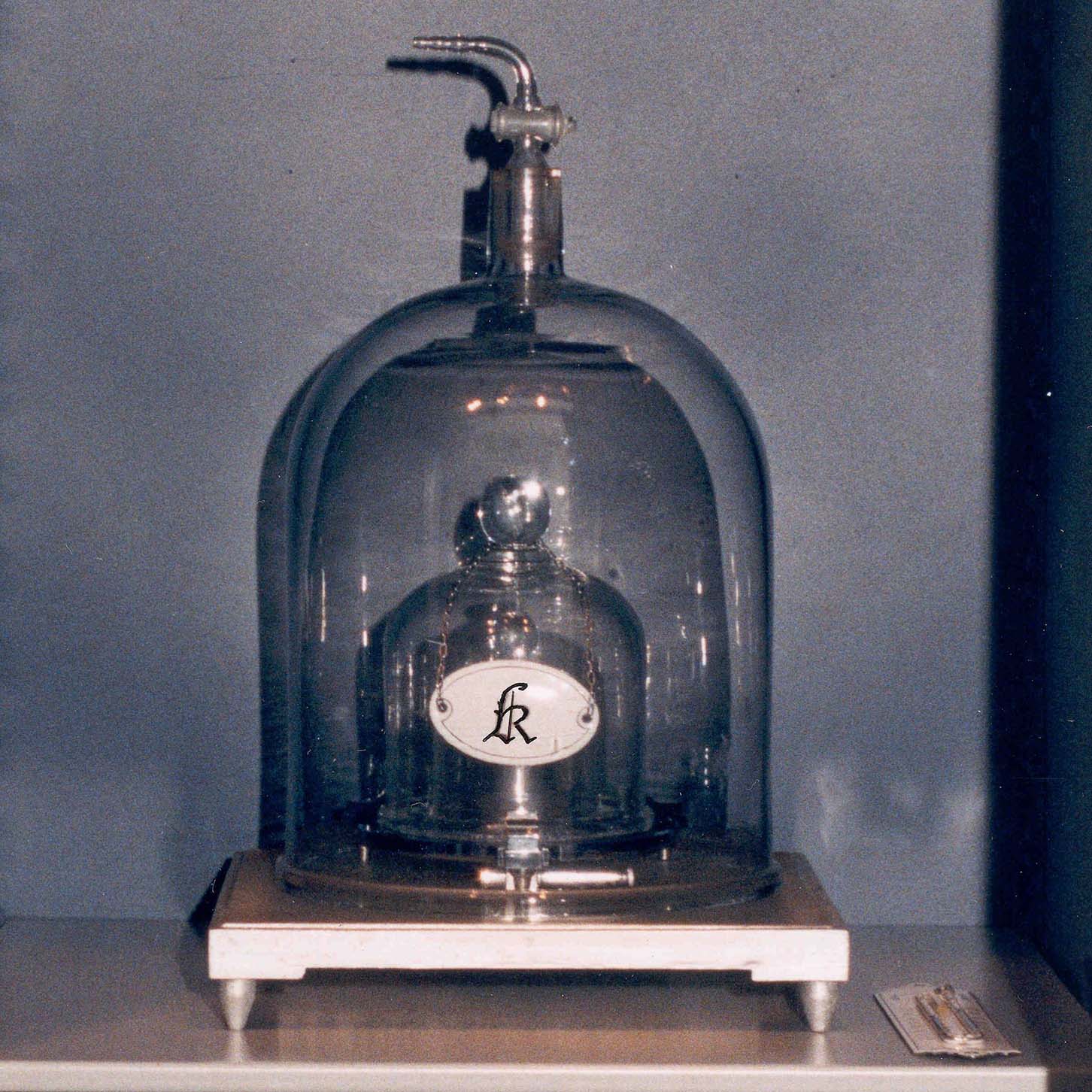Revamping the Kilogram for the Quantum Age
Virtually no one gets an audience with “Le Grand K,” the official arbiter of weight measurement for well over a century. More formally known as the International Prototype Kilogram, or IPK, the diminutive metal cylinder dwells in a locked safe inside a climate-controlled vault at the International Bureau of Weights and Measures (known by its French acronym, BIPM) in the suburb of Sèvres, some 6 miles southwest of central Paris. To open the vault, three separate keys, held by three different officials, are needed.
Richard Davis, the Connecticut-born physicist who showed me around the BIPM during a recent visit, was cagey about the vault’s actual location: “I won’t say what room it’s in, but it’s in this building.” We had a look at the facility’s many duplicate kilograms, but the IPK was, not surprisingly, off limits. Still, Davis was happy to describe it to me: It’s made from an alloy that’s nine-tenths platinum and one-tenth iridium; it’s cylindrical in shape; its height is just under 4 centimeters (a bit over 1.5 inches) and its diameter is about the same.
It weighs, of course, one kilogram. In fact, it weighs one kilogram by definition. When we say that a package of sugar, for example, weighs one kilogram, what we mean is it weighs the same as the Parisian cylinder. But the IPK’s days are numbered. At the 26th General Conference on Weights and Measures held in Versailles last November, scientists from 57 countries voted to change the definition of the kilogram. The new definition will be based on the value of a fundamental constant of nature, known as Planck’s constant — and when it takes effect in May, the IPK will face a Pluto-style demotion.
While the re-definition won’t have an obvious impact on the average consumer, it will have a ripple effect that will influence all future determinations of weight. After all, your local supermarket scale has to be calibrated against a set of metal weights, which in turn are calibrated against other weights, which in turn eventually lead back to the IPK. All of which is, ultimately, a headache. Even worse, the IPK might be gaining or losing a tiny amount of weight over time — which in turn casts doubt on all other weight measurements.
Under the new system, weight calibrations can, with the right equipment, be done locally, making the trip to Paris redundant. A kilogram based on Planck’s constant, unlike the IPK, will never shift. And while the weight of bananas at the supermarket won’t measurably change, precision is crucial in certain fields, like pharmaceutical production or in monitoring industrial pollutants, where milligrams and even micrograms matter.
When the metric system was first developed in the wake of the French Revolution, the aim was to make a system of weights and measures that was as free from arbitrary definitions as possible; ideally, the units were to be derived from the planet we live on.
Thus the meter was declared to be one ten-millionth of the distance from the equator to the North Pole, along a meridian running through Paris. And yet, a physical prototype was still needed: a platinum-iridium bar of exactly this length was cut, and it became the official meter; copies were distributed around the world. The second, meanwhile, was defined as one part in 86,400 of the mean solar day (the average length of time for the Earth to complete one rotation relative to the sun).
But how big should a kilogram be? The obvious solution was to link it to the meter: It was initially defined as the weight of a cube of water one-tenth of a meter on a side at 4 degrees Celsius. The “4 degrees” requirement was needed because water expands and contracts with changes in temperature — which unfortunately makes the definition a bit clunky. And so, in 1779, the French government defined the kilogram as the mass of a platinum cylinder that embodied as closely as possible the ideal definition based on water.
In 1889, delegates at the General Conference on Weights and Measures in Paris decided to go with another physical prototype: a manufactured object that would simply be defined as weighing one kilogram, and that was carefully manufactured to have the same mass as the 1799 kilogram, which was borrowed for the purpose. A gram, naturally, would be one-thousandth of this weight, and a milligram one-thousandth of that, or one millionth of a kilogram. Large or small, all weights are derived from the one-kilo prototype.

The IPK was placed in its vault near Paris, where it remains to this day. Just to be safe, two identical cylinders, known as témoins, or witnesses, were crafted at the same time (the number of witnesses was later increased to six, and several dozen other identical cylinders were also made for distribution to various countries). And that’s when the problems began: Over time, the kilogram keepers noticed that the witnesses weighed slightly more than the IPK, and no one knows if the IPK is getting lighter (the result of physical deterioration or damage) or if the witnesses are getting heavier (through the build-up of contaminants) — or some combination of both. “It’s an artifact,” Davis says of the IPK. “There’s no guarantee that it stays stable.”
The trouble with a physical prototype is that if catches a cold, everything derived from it sneezes, so to speak. “It doesn’t matter if you put a thumbprint on it; it’s still one kilogram — and the whole rest of the world gets lighter or heaver to follow it,” says Barry Wood, a physicist at the National Research Council in Ottawa, home to Canada’s official kilogram. (Manufactured from the same material as the IPK, the Ottawa kilogram is shipped to the BIPM for recalibration every few years.)
As scientists came to recognize the inadequacy of physical prototypes — and developed more precise measurement methods — the definitions of both the second and meter were tweaked. In 1960, the meter was re-defined as the length of a certain number of wavelengths of radiation emitted by a particular isotope of krypton. Then, realizing that the vibrations of atoms were better clocks than the rotation of the Earth, physicists in 1967 redefined the second as the length of time required for 9,192,631,770 oscillations of a particular isotope of cesium. With the second pinned down, it made sense to re-define the meter yet again, and in 1983 it was set as the distance that light travels in 1/299,792,458th of a second. (With the meter re-defined, the speed of light has been fixed at 299,792,458 meters per second.)
What’s the equivalent trick for mass? Here, physicists turned to another constant of nature, Planck’s constant. And no one seems better qualified to explain Planck’s constant than Jon Pratt, who has its precise value tattooed on his forearm. (From his David Byrne-like appearance, I guessed — correctly, it turns out — that he’s a part-time musician.)
Pratt was, until late last year, the chief of the Quantum Measurement Division at the National Institute of Standards and Technology (NIST) in Gaithersburg, Maryland. Planck’s constant, he explains, comes up in the equations of quantum mechanics, and is denoted by the symbol h. According to a measurement performed by NIST scientists in 2017, it’s equal to — and here I leaned toward Pratt’s arm to get a closer look — 6.626069934(89) x 10-34 J s. The parentheses around the last two digits indicate that physicists aren’t quite sure about them (still, nine decimal places is pretty good), and “J s” refers to joule-seconds, the joule being a unit of energy. (One joule-second is one joule multiplied by one second.)
Fortunately, one joule is also equal to one kilogram-meter-squared per second squared — which means that Planck’s constant has the kilogram baked into it, so to speak. So the hope has been that if physicists could pin down Planck’s constant with adequate precision, they could then define it as a fixed quantity — as they did with the speed of light — thus paving the way for a new definition of the kilogram.
“Practically, it’s complicated; but conceptually, it’s simple,” Pratt says. He cites two equations — the familiar E=mc2 and the somewhat less familiar E=hv. The first equation connects energy and mass via the speed of light; the second connects the energy and frequency (v) of a photon (a particle of light) via Planck’s constant (h). With those two equations in hand, Pratt says, “I’ve got a relationship from which I can coax out mass.”
That’s where a remarkable device known as the Kibble balance comes in. In a Kibble balance, an object’s weight is balanced by an electromagnetic force — one that can be controlled with great precision by adjusting the current flowing through a wire. Once the forces are balanced, and some additional measurements have been made, you can use the object’s mass to work out the value of Planck’s constant. Once you’re confident that you’ve measured Planck’s constant as well as you can, you can “fix” its value, and use the Kibble balance to give you an object’s mass.
And that’s where we are now: As of this spring, Planck’s constant will be fixed, just as the speed of light was fixed back in 1983. The official value will be 6.62607015 x 10-34 J s, a refinement of the value Pratt got tattooed on his arm that reconciles the NIST result with one from an international collaboration that used an entirely different method.
But the number isn’t the most interesting part of Pratt’s tattoo. Neither is the Lady Liberty-like figure just above it, holding a meter stick in one hand and a kilogram weight in the other. The key message is inked above her: “A tous les temps, a tous les peuples” (“For all times, for all people”) — a motto attributed to the Marquis de Condorcet, the French philosopher and mathematician who advocated for what we now call the metric system (as well as for racial and gender equality).
As we move toward a system of weights and measures based solely on universal attributes of nature, Pratt says, we make weighing and measuring more democratic. And the drive to develop a system we can all agree on has brought people together. It’s been a unifying force.
“We want to share our experience — and the way that we can share our experience is to agree on our observations of the world,” Pratt says. As long as different peoples and nations use different systems of measurement, bickering is inevitable. “It would further humanity if we could agree on a common basis for measurement,” he says.
In fact, simply setting out to establish those common measures has had a unifying effect. Pratt points to the case of Pierre Méchain, one of the French scientists charged with surveying the Paris meridian from Dunkirk to Barcelona in the 1790s to help pin down the length of the meter. The task required him to make measurements on Spanish territory, which was awkward, given that France and Spain were at war. But the Spanish authorities, feeling that Méchain’s work was for the good of humankind, allowed him to make the necessary triangulations in Barcelona, and gave him supplies, even as the two armies clashed on the battlefield. “I think that’s a very positive and powerful commentary on what humanity is capable of,” Pratt says.
It is often misleadingly said that the United States is one of the very few countries — along with Liberia and Myanmar — that has yet to officially adopt the metric system. And yet American scientists and researchers have long used metric units in their work — it just hasn’t trickled down to everyday usage. As Pratt notes, “we are addicted to the units of measure that we grew up with.”
While the revised kilogram might be good for humanity, it does not bode well for Le Grand K. Just as Pluto is now one of many dwarf planets, the IPK will soon be just another one-kilogram cylinder — a “humiliating demotion,” as the author Simon Winchester put it recently. And yet few of the physicists I spoke with seemed nostalgic for its passing. Only Patrick Abbott, a physicist and colleague of Pratt’s at the NIST, seemed somewhat sentimental.
“With all of its faults, with all of its warts, with all the infrequent use, it’s still done a very, very good job for over 130 years,” he says. “And it’ll be kind of sad to let that part of history go. But it’s time. When something new comes along that can do a better job, it’s time.”
Dan Falk (@danfalk) is a science journalist based in Toronto. His books include “The Science of Shakespeare” and “In Search of Time.”











Comments are automatically closed one year after article publication. Archived comments are below.
So they know exactly how much it exactly weighs.
But do too heisenberg uncertainty principle they can’t be precisely where it is ????